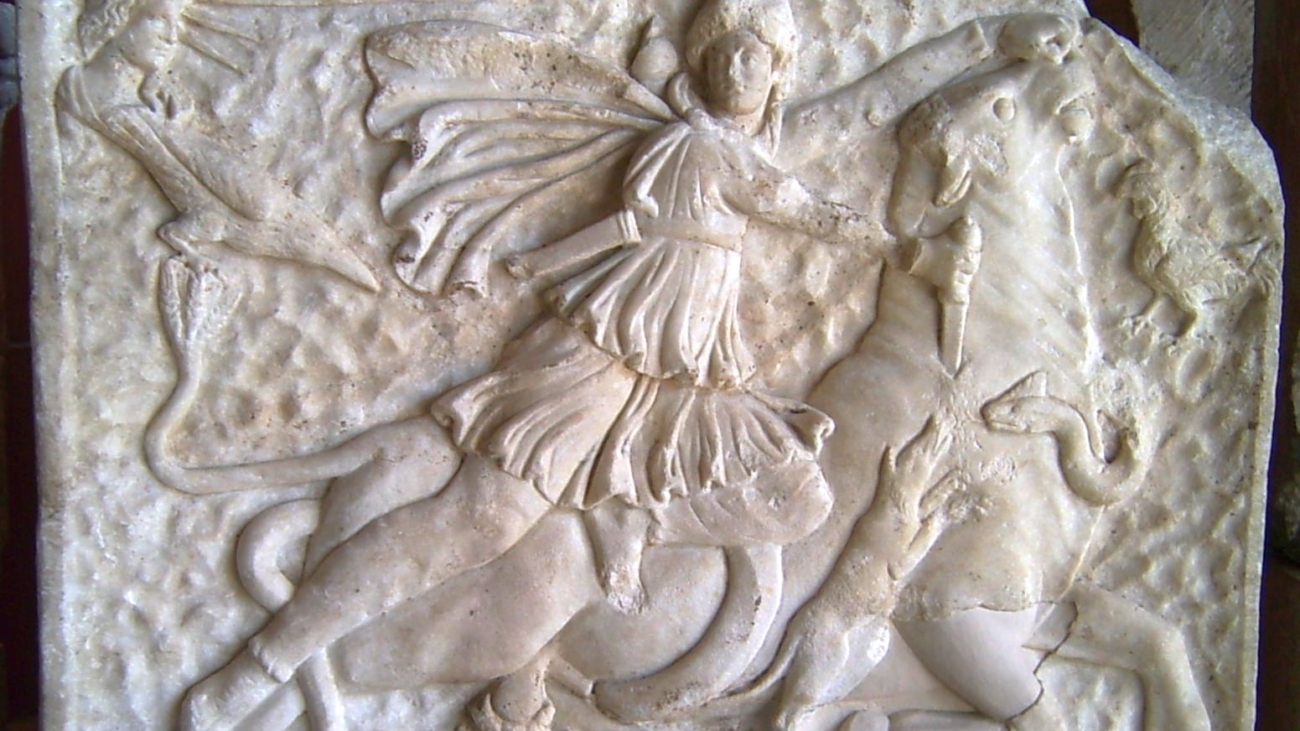One of the reasons Crowley’s project with OTO is so often misunderstood is because it is an implementation of Thelema as a mystery religion, and we don’t really have a category for that in modern spirituality.
Reflections on the Path in Eternity (Part 1)

I was recently inspired to create an animated movie based upon my understanding of the Path in Eternity and its relation to certain magical formulae.
The phrase Path in Eternity comes from a passage in Magick Without Tears where Aleister Crowley is describing the initiation rituals of the Man of Earth degree of Ordo Templi Orientis.
Let us begin at the beginning. What is a Dramatic Ritual? It is a celebration of the Adventures of the God whom it is intended to invoke. (The Bacchae of Euripides is a perfect example of this.) Now, in the O.T.O., the object of the ceremonies being the Initiation of the Candidate, it is he whose Path in Eternity is displayed in dramatic form.
Magick Without Tears, Chapter 13, The System of the O.T.O.
He then describes this Path in Eternity in relation to the six sub-degrees of the Man of Earth in the following way:
- O° – Minerval – The Ego is attracted to the Solar System.
- I° – Initiation – The Child experiences Birth.
- II° – Consecration – The Man experiences Life.
- III° – Devotion – He experiences Death.
- IV° – Perfection, or Exaltation – He experiences the World beyond Death.
- P.I. – Perfect Initiate – This entire cycle of Point-Events is withdrawn into Annihilation.
There are three important conclusions to draw here.
First, as in the mystery schools of the ancient world, the purpose of O.T.O. initiation—in particular, this series of six sub-degrees that comprises the Man of Earth—is to introduce a single individual or candidate to a single god. The main difference between the O.T.O. initiations and those predecessor schools is that in O.T.O., the god the candidate is being introduced to is none other than themselves. In Thelema, the term for this god—the divine part of each individual—is the Secret Self or Hadit.
Second, the purpose of the Man of Earth initiations is to dramatize the “path” taken by this god: a complete cycle in which the soul is drawn into incarnation, dies, and is withdrawn back into nothingness. The initiations are conducted in service to and with reverence toward that way of going which is characteristic of the Hadit which all of us truly is. The Path in Eternity is that toward which the entire series of rituals is oriented. The rituals derive their meanings from that Path.
Third, that path has a characteristic shape. It’s cyclical. It’s a passage from silence to speech and back to silence again. This is the exact same path as that taken by the Holy Guardian Angel which Crowley describes in Liber DCLXXI vel Pyramidos and which I quote at the beginning of the video:
For from the Silence of the Wand
Unto the Speaking of the Sword,
And back again to the Beyond,
This is the toil & the Reward.
This is the Path of HVA—Ho!
This is the Path of IAO.
So one of the first points I’m making in the video is that the Man of Earth series of initiations connects at a deep level with one of the core concepts of Thelema, namely, the idea of the Secret Self aka Hadit aka the Holy Guardian Angel.
The particular way in which it connects with that core concept is to show the characteristic going of that god, and to show how that way of going makes contact with an individual human life. In other words the conditions we find ourselves subject to—birth, aging, and death—are not incidental or exterior to our divinity. In fact they are necessary components of the way our divinity expresses itself.
This helps us begin to make sense of another one of the claims Crowley makes about these rituals:
The main objects of the instruction were two. It was first necessary to explain the universe and the relations of human life therewith. Second, to instruct every man how best to adapt his life to the cosmos and to develop his faculties to the utmost advantage. I accordingly constructed a series of rituals, Minerval, Man, Magician, Master-Magician, Perfect Magician and Perfect Initiate, which should illustrate the course of human life in its largest philosophical aspect. I begin by showing the object of the pure soul, “One, individual and eternal”, in determining to formulate itself consciously, or, as I may say, to understand itself.
Aleister Crowley, Confessions
This larger, universal context in which Crowley wishes to situate or orient the individual human life is the aforementioned Path in Eternity, which in turn is the characteristic way of going of Hadit.
Liber V vel Reguli and the Formula of AHIHVH

I spent some time recently looking closely at Liber V vel Reguli along with the commentary and the early draft notes, and feel like I have come to a few insights which could be of use to others.
As I’ve shown before, one of the main themes of Crowley’s spirituality is the movement from speech to silence and back again. This could also be viewed as the expression of nullity (Ain of Kabbalah) into manifestation (the Tree of Life itself) and the individual’s path of return back to nullity. The first part of this equation expresses Thelemic cosmology, the latter Thelemic soteriology.
In Reguli these movements are dramatized and expressed in the formula LAShTAL. LA means “not,” while AL means “God”. LA and AL represent nullity in concealment and manifestation respectively, while ShT is the process that mediates between them.
In order for ShT to mediate between LA and AL, they have to conjointly share something in common between LA and AL while also adding new information.
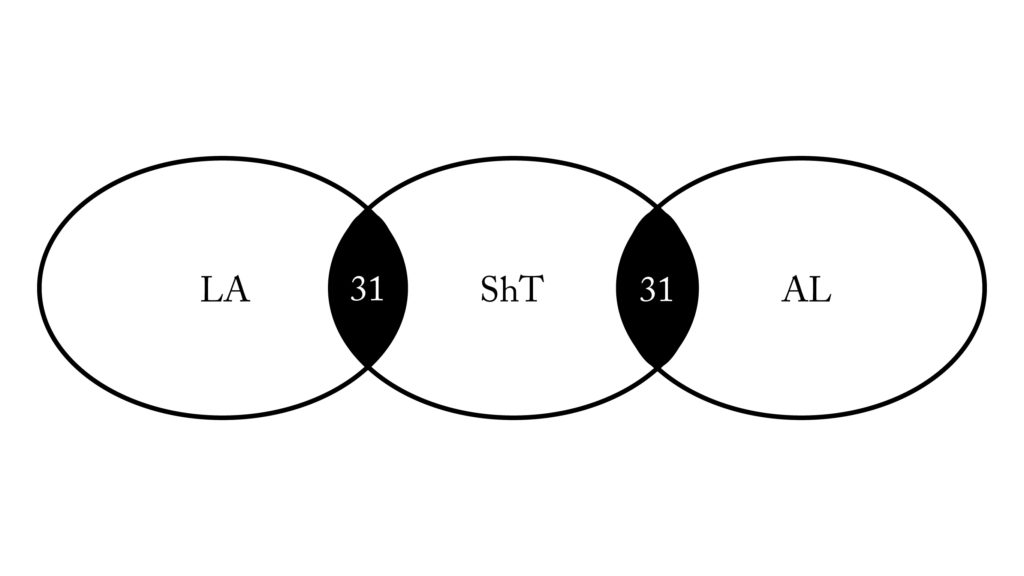
LA and AL both add to 31 by gematria. ShT also adds to 31 by way of the tarot cards these letters are attributed to. Sh or Shin is the Hebrew letter assigned to The Aeon, Atu XX, and T or Teth is assigned to Lust, Atu XI.
As someone recently pointed out to me, there is a tradition in the Golden Dawn, recorded in the Z1 document, of ST denoting an influence from Kether. ST is the Coptic letter ⲋ (“ⲥⲟⲟⲩ” or “soou”). Crowley continues this tradition by assigning this letter to Kether in 777, Column LI.
So by means of its association with 31 and Kether, ShT is identical with the (N)One at the foundation of Thelemic ontology and theology.
But ShT has an additional function. It also indicates the Beast and Babalon conjoined. It is a sexual formula. This sexual formula is indicated by how it is represented in Reguli on the human body and on the Tree of Life.
In the ritual, Aiwass, Therion, and Babalon are attributed to the cross paths of the Tree of Life: Daleth, Teth, and Pe respectively. The cross paths are important as they mediate between the Pillar of Severity and the Pillar of Mercy.
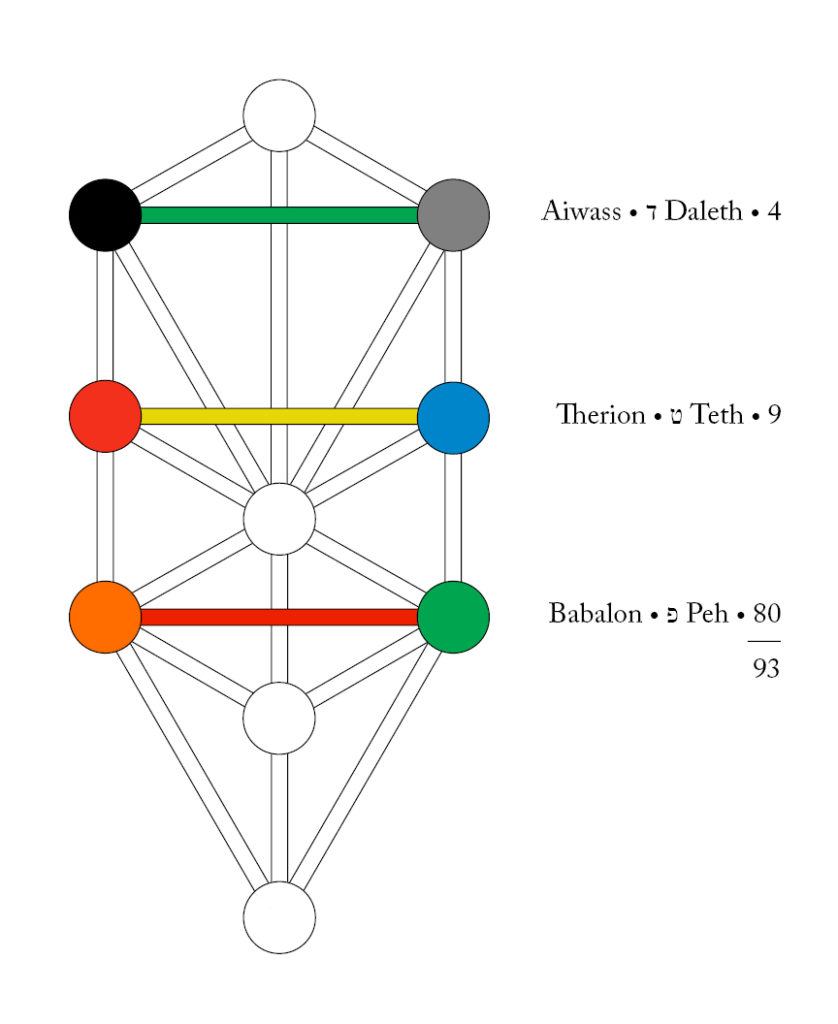
As taught in the Golden Dawn 4°=7□ ritual, the left pillar, the Pillar of Severity, is associated with the letter Shin, which is assigned to elemental fire, while the right pillar, the Pillar of Mercy, is Mem or elemental water. The Middle Pillar is then Aleph, which is elemental air. Fire is archetypally masculine, water feminine, and air androgyne.
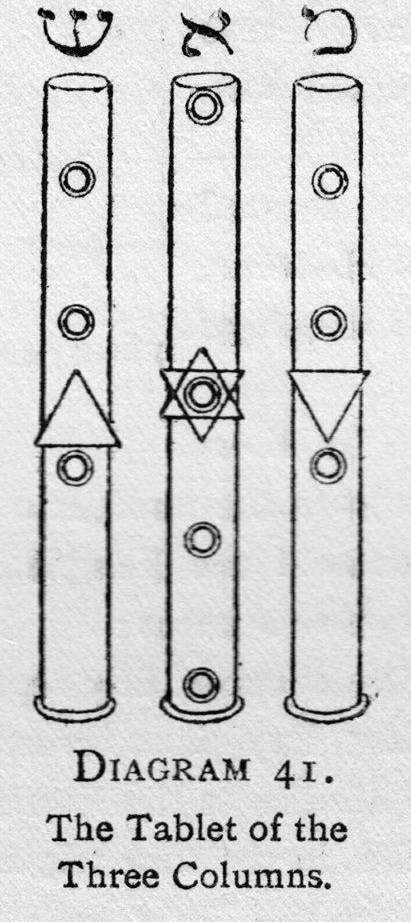
However, these sexual characteristics are not assigned to the pillars in a straightforward way. While the Pillar of Severity is fiery and masculine, the topmost sephira, Binah, is archetypally feminine. She is the supernal Mother. And opposite her, on the Pillar of Mercy, we find Chokmah, which is archetypally masculine, the supernal Father. They are “reflected” in Netzach (masculine-feminine) and Hod (feminine-masculine) respectively, as Kether is reflected in Tiphareth. This reflection occurs both horizontally across the Tree (Binah and Netzach and Chokmah and Hod are opposite each other across the Middle Pillar) and vertically down the Tree (they are opposite Tiphareth). The vertical and horizontal “components” of Liber V vel Reguli work with this double-reflection of sexual energy.
One can view this double-reflection of magical sexual polarity taking place on the Tree as a movement of energy down the Tree of Life from Kether into the subsequent Sephiroth along the paths. One androgyne current emerging from Kether, represented by the path of Aleph, becomes masculine upon reaching Chokmah. There it progresses down the tree along the archetypally masculine paths of Vau, Yod, Ayin, and Resh, into Yesod. In Yesod it is met by a complementary feminine path, originating with Beth’s entry into Binah, and progressing down the Tree along the paths of Cheth, Lamed, Nun, and Tzaddi.
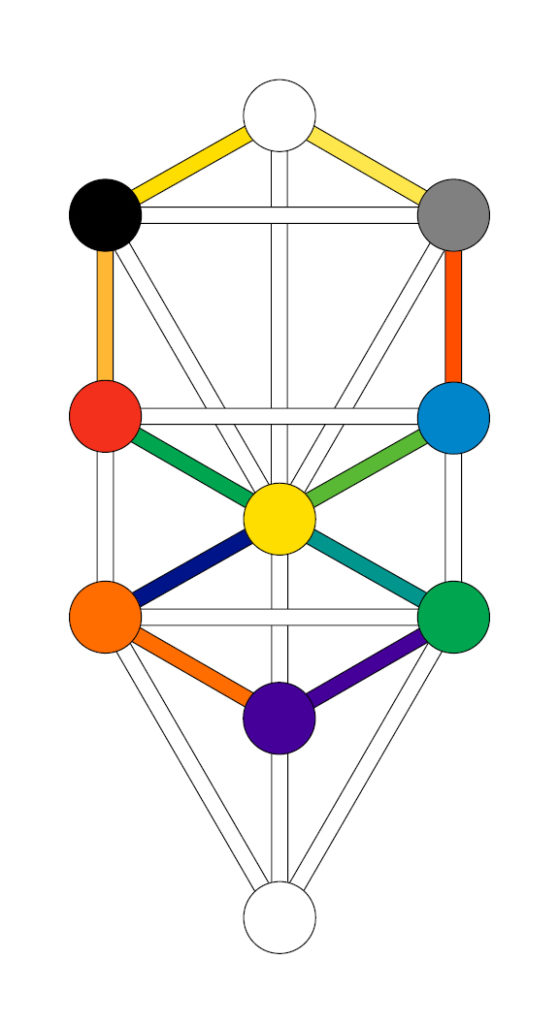
This exchange and “mixing in Yesod” is represented on the Art card, Atu XIV. Art is a hieroglyph of the path of Samekh, which links Yesod with Tiphareth. Here we see the Lion and the Eagle which have exchanged their colors as represented earlier on the Lovers card, Atu VI. If the paths on the Tree represent these essences or potencies, then they were exchanged at Tiphareth, a sphere which, among other things, is the site in which the Rose (Kteis) and Cross (phallus) are conjoined. The caldron is Yesod, which is linked with the sexual organs and the Muladhara cakra. We see spiritual air—presumably the Medicine of Metals—rising out of the caldron, represented by the arrow, as the Caput Mortuum (skull) drops to the bottom.
The cross paths are important to this process, because they are mediating the exchange of energies down the Tree. They are in a sense guiding and determining the separation and mixing of these sexual polarities. That these paths add up to 93 is significant. It tells us that the 93 magical current has something essential to do with the production of sexual polarity from out of androgyny and back again. It has to do with the movement of 0 to 2 (magick) and from 2 to 0 (mysticism), both as a personal spiritual journey and as a cosmological process. Aiwass, Therion, and Babalon are personages representing these governing principles.
For me personally, this is not simply theory. When I’m serving as Priest in the Gnostic Mass, I picture this exchange of energy occurring—moving down and wrapping around and joining mine and the Priestess’s hearts—at the consummation of the eucharist. We are linked energetically at the levels of mind (Daleth and Kether), heart (Teth and Tiphareth), and body (Peh and Yesod). The Tree of Life with the cross-paths can also be used as scaffolding for visualizations during sex magick workings.
If the horizontal component is governed by Aiwass, Therion, and Babalon, the vertical component is governed by Nuit, Ra-Hoor-Khuit, and Hadit. Nuit is associated with the Sahasrara cakra/Kether/the Three Negative Veils; Ra-Hoor-Khuit is linked specifically with the Anahata cakra and the paths of Teth, Yod, and Lamed (which add to 49), but also arguably with the entirety of the Tree in manifestation (hence Microprosopus); and Hadit is linked with the Muladhara cakra and Yesod and/or Malkuth (Crowley refers to this as the “seed” in his commentary).
The conjunction of Nuit and Hadit produces the godhead, Ra-Hoor-Khuit (or Heru-Ra-Ha, so as to include Hoor-paar-kraat). Hadit, as the consciousness or point of view of the individual, is implanted in Malkuth as a seed represented by Heh-final, the Virgin Daughter whose destiny is to be seated upon the Throne of the Mother (Binah). Crowley consistently related the three deities of the Book of the Law to the Tree of Life this way.
So one thing to take note of when attempting to understand LAShTAL is that it shares the same form or structure taken by these three personages in relation to the Tree of Life. You have two simple extremes mediated by a complex third thing sharing characteristics with both of the extremes. Indeed, the entire Tree of Life itself—or Ra-Hoor-Khuit—could be seen as a means of mediating between these oppositions.
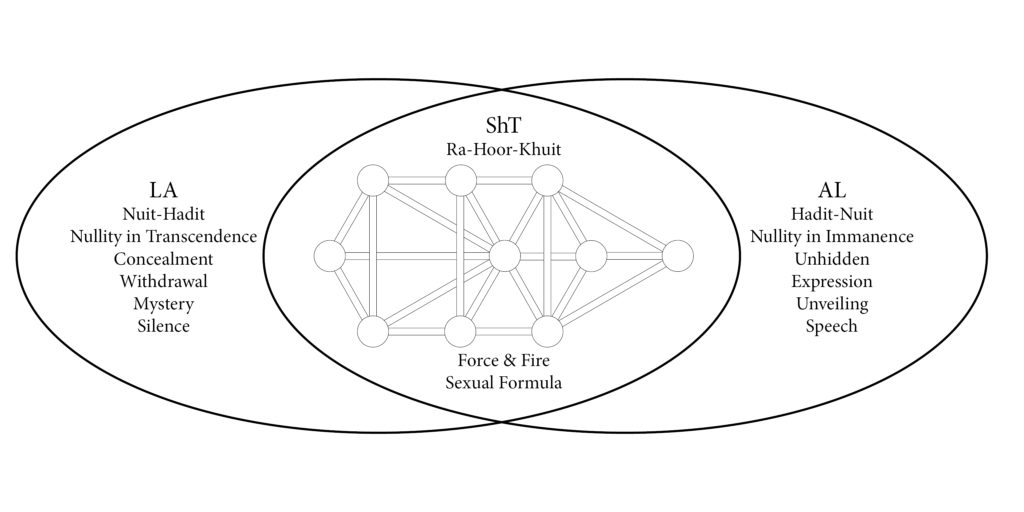
But how does the introduction of the horizontal component modify or inform this cosmological and theological process of the implantation, germination, and return of Hadit to the source?
The cross-paths enter into this as they are involved in the drawing of the Hexagram of Nature on the Tree of Life. Generally speaking, the hexagram is the symbol of the union of the individual with the divine, with the mirroring in the microcosm of the structure of the macrocosm. As such it is symbolic of the individual who has become divine. The cross-paths of Teth and Pe are involved in this hexagram—in fact are the only actual paths involved—as they form bases of the two interlocking triangles.
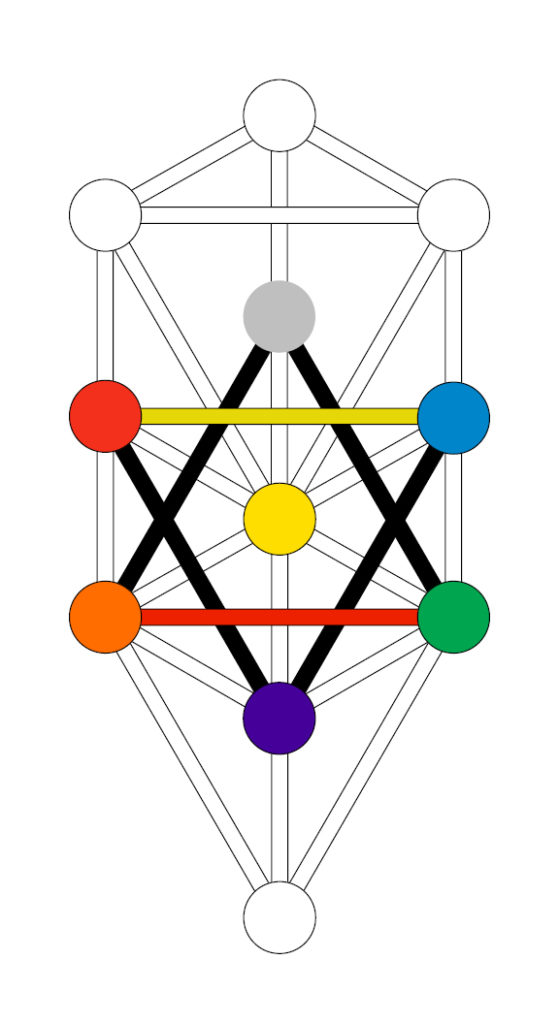
Typically the upward-pointing triangle represents fire and is therefore masculine, while the downward-pointing triangle is water and feminine. But a different connotation is suggested in Reguli where the base of the upward-pointing triangle is assigned to Babalon, and the base of the downward-pointing triangle is Therion. The polarities are reversed.
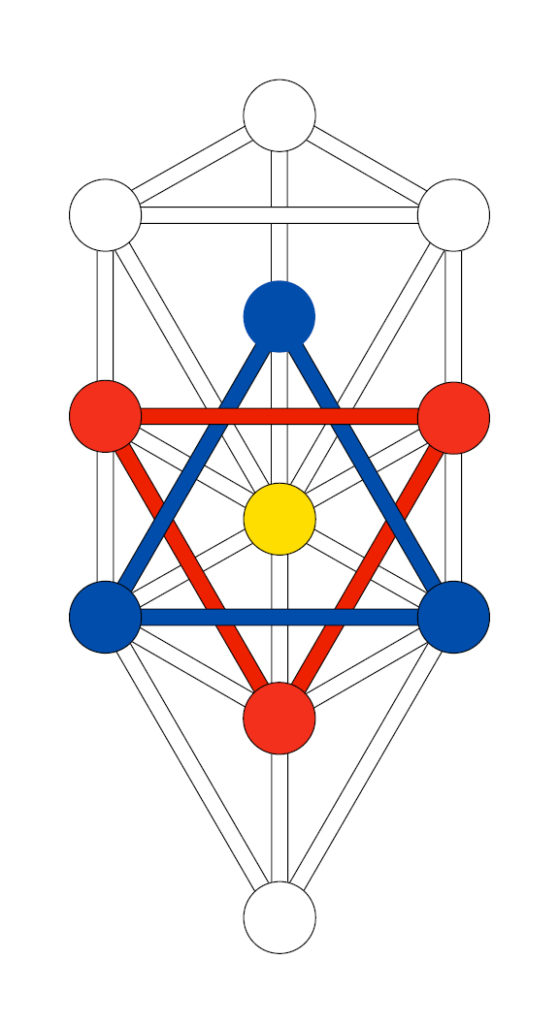
This suggests not so much the familiar Hexagram of Nature but rather the Magical Hexagram as described by Crowley in the Book of Lies, where fire points down and water up.
In the ordinary Hexagram, the Hexagram of nature, the red triangle is upwards, like fire, and the blue triangle downwards, like water. In the magical hexagram this is reversed; the descending red triangle is that of Horus, a sign specially revealed by him personally, at the Equinox of the Gods. (It is the flame desending upon the altar, and licking up the burnt offering.) The blue triangle represents the aspiration, since blue is the colour of devotion, and the triangle, kinetically considered, is the symbol of directed force.
Book of Lies, Chapter 69
Crowley explicitly associates force with the path of Teth in Reguli, as he associates fire with Shin. Hence ShT represents “force and fire”. In the context of the ritual, these triangles would interlock and interpenetrate around Tiphareth, representative of the Anahata cakra, Ra-Hoor-Khuit, and, as we saw earlier, Kteis-Phallus or the Rose-Cross.
As the upward-pointing blue triangle represents Babalon, the Mother, we could attribute the three Mother Letters (Aleph, Mem, and Shin) to its three points, as we might attribute the masculine trinity, IAO, to the three points of the downward-pointing red triangle. Their conjunction gives us the word AShIAVM, which has the same value as MShICh (Messiah) and NChSh (Nechesh, Serpent).
The Messiah or Anointed One affects the union between the individual and the divine. The Serpent in the Garden of Eden is the initiator of mankind into knowledge or gnosis. In Thelemic soteriology, this saving, initiating power is not one individual but rather the conjoining of two individuals, Therion (666) and Babalon (156). And the way in which this union between the divine and the individual is affected is sexual in nature.
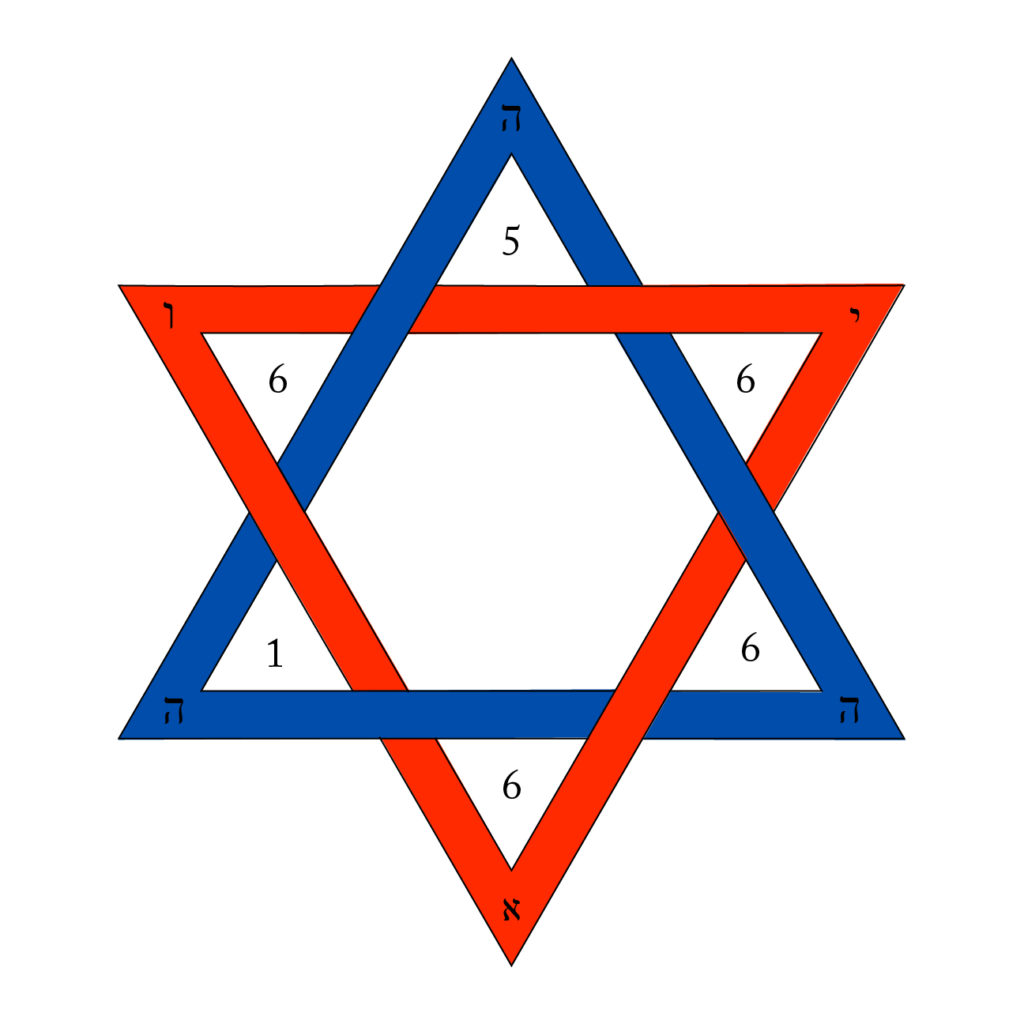
In this formula AShIAVM, the three mother letters are concealed by the letter Heh, giving us AHIHVH, the Great Name which is the conjunction of AHIH and IHVH.
AHIH is the godname of Kether. It represents existence in is most abstract quality or Macroprosopus. In the context of Reguli, it is LA, Nuit and Hadit conjoined.
IHVH represents god in manifestation or Microprosopus. It enumerates to 26 by gematria, which is 13 x 2. 13 is the enumeration of AChD or unity. IHVH therefore expresses unity (AL) by means of duality (ShT or Beast and Babalon conjoined). It is the way in which nullity expresses itself in manifestation or as the Tree of Life or 0=2.
Antonio Lau has come to a similar conclusion in his analysis of how the formula of AHIHVH relates to the Lesser Ritual of the Pentagram:
The conclusion would be that all the points of the Lesser Ritual of the Pentagram (32) on the whole create another Hexagram that symbolizes the Qabalistic Zero, radiating from the center of the Column and flooding the whole Circle with the Limitless Light of Ain Soph Aur. And the Hexagram is the formula of unifying opposites (positive and negative, active and passive, male and female), by the 0=2 Equation.
This sheds light on what it means that Reguli is meant to “invoke the energies of the Aeon of Horus.” The “first gesture” of the ritual—the drawing of the Elevenfold Seal—is depicting the unfolding process leading to the creation of the cosmos. It is also establishing the scaffolding—the cross-paths—that allow for the process of return. The “second gesture”—in which the Son raises the Daughter to the Throne of the Mother—is the familiar process of Tetragrammaton which, by means of sexual interaction between Son and Daughter, the process of return takes place. What Reguli adds to this conception is the idea that Nuit and Hadit (Daughter and Son) must become “sexually mature” as Babalon and Therion on their way of return.
AHIHVH is important for other aspects of Crowley’s spirituality. He relates it to the Lesser Ritual of the Pentagram. By means of the LRP it is indirectly connected with the production of the Medicine of Metals. The connection with the Medicine of Metals is made explicit through Crowley’s discussion of the production of the Eucharist of Six Elements in Magick in Theory and Practice Chapter 20. The production of this medicine is a secret guarded by the Sanctuary of the Gnosis of O.T.O. This formula is also the guiding structure behind Liber HHH, which describes some of the work of the Outer College of A∴A∴. At least one Thelemic author, J. Daniel Gunther, has made an extensive case for the AHIHVH formula being essential to a comprehension of Thelemic initiation in general. (See Initiation in the Aeon of the Child and The Angel and the Abyss.)
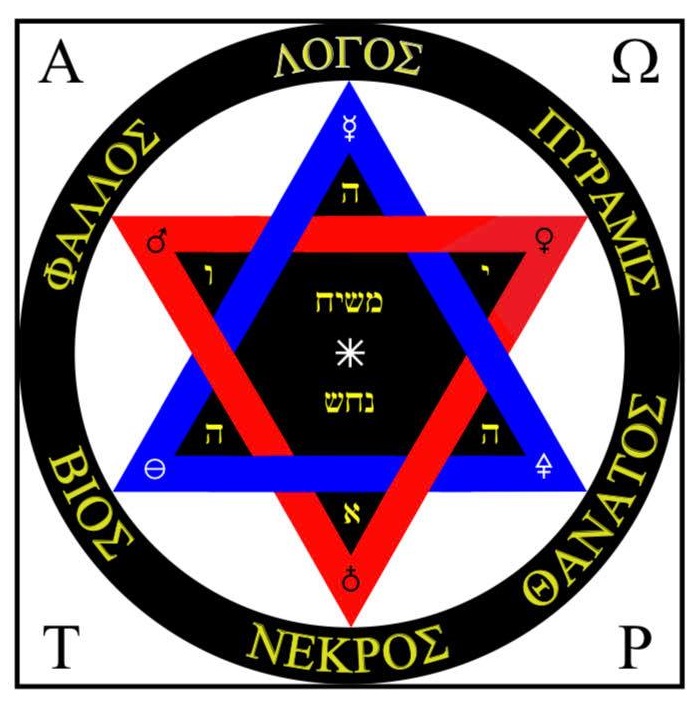
As I said in my recent talk on art and magick, when a magical formula is involved in so many disparate aspects of Crowley’s magick—especially when it illuminates mysteries of both A∴A∴ and O.T.O.—you can bet it is essential to an understanding of Thelemic spirituality generally. I hope to deal with this formula in greater depth in subsequent writings, exploring more fully its importance for Thelemic magick generally.
As for Reguli, my treatment of it here is not exhaustive. I have hardly dealt with the function of the cross-path of Daleth or how Aiwass figures into all of this. (There’s another hexagram that uses the path of Daleth as the base of a triangle.) I didn’t even touch on the elemental attributions of the deities/quarters, and I barely dealt with the significance of the cakras. But hopefully this shows the way in which Reguli is expressive of the underlying ontology and theology of Thelema and how the sex magick implicit in it relates to Crowley’s broader spiritual concern as expressed in the AHIHVH formula.
The Power Behind the Mass
My talk on Eucharistic magick is online now. It includes an in depth analysis of Sections VI-VIII of Liber XV: The Gnostic Mass.
The claim I make about the Mass—if I were to state it as succinctly as possible—is that the Mass was intended, in part, to bring into physical manifestation the spiritual power which was the source of the Book of the Law. So you can profitably view it as an attempt to bring the spiritual force of Thelema into the world by means of a public religious rite.
On the one hand, there’s nothing new or terribly controversial in such a statement. The Gnostic Mass is clearly a religious rite, and the purpose of a religious rite is for clergy to administer certain ideas, values, or virtues to a congregation. It would be rather odd to make the opposite argument, that Aleister Crowley created a religious service that administered the virtues of some spirituality other than Thelema.
I think what’s bound to make my argument controversial is the specificity of it. I don’t treat the power or spiritual potency from an abstract point of view. I show how Crowley specified it, put names to it, and even described its nature. If you accept the premises and the inferences to the conclusions from those premises, this creates a backstop for what is going to count as a good interpretation of the Mass. (Or it brings whatever existing backstop there is closer to the home plate.)
Considering the Mass alone, Crowley has many names for this spiritual potency or power considered in and of itself:
- “one secret and ineffable LORD”
- “our Lord …”
- “the LORD” (symbolized by the priest’s serpent crown)
- “O secret of secrets that art hidden in the being of all that lives”
- “the flame that burns in every heart of man, and in the core of every star”
- “Life, and the giver of Life”
- “Lord secret and most holy, source of light, source of life, source of love, source of liberty”
- “force of energy, fire of motion”
- “Thou who art I, beyond all I am, Who hast no nature and no name”
- “center and secret of the Sun”
- “hidden spring of all things known and unknown, Thou aloof, alone”
- “true fire within the reed”
- “source and seed of life, love, liberty, and light, thou beyond speech and beyond sight”
- “One in Three … Three in One”
What we can gather from these terms is that there is a divinity or a portion of divinity that is secret, ineffable, withdrawn, unmanifest, and completely transcendent. It is beyond our ability to describe or understand it. It is characterized by silence, but it is the source of speech and motion. And this divinity or some aspect of this divinity is concealed “within us” in some sense, and it is responsibility for our vitality.
Now one thing you may want to ponder from a theological or metaphysical perspective is this: If something is truly transcendent and unmanifest—if it is really “aloof, alone”—then how does it enter into manifestation? How does it have anything to do with the visible or manifest universe at all?
Crowley’s phrase for this in the context of the Mass, exemplified in the Creed, is the “Miracle of Incarnation”. He claims it is accomplished by means of the “Baptism of Wisdom”. As Sabazius has pointed out, this comes from Van Hammer’s elucidation of the name Baphomet as Baphe-Metis, the Baptism of Wisdom. One of the arguments I make in the talk is that, in the context of the Mass, Baphomet is the name given to this pure, transcendent spiritual potency when it is embodied or incarnated. This means that we can understand the Epiklesis of the Gnostic Mass on analogy with the transubstantiation of the Eucharist in the Roman Mass into the body and blood of Christ. This helps make sense of why the elements of the Eucharist are consecrated into a resurrection structure in Section VI. As Christ is the principle of resurrection in Christianity, Baphomet is the principle of resurrection in Thelema. At that point, the doctrines diverge, and I spend a lot of time in the talk examining exactly what resurrection means in a Thelemic context.
One angle I did not explore very much at all in my talk is how this transcendent spiritual potency is made manifest by the sex instinct. The only reference I made to this extraordinarily complex and interesting subject was to point out that the Priest, by virtue of the Lance and the scarlet robe, represents the microcosmic deity in the context of the Mass. This microcosmic deity is called “CHAOS, the sole viceregent of the Sun upon the Earth.” It is also called phallus. It is the “Lord of Life and Joy, that art the might of man, that art the essence of every true god that is upon the surface of the Earth, continuing knowledge from generation unto generation”. The magick of the Mass is almost certainly intended to parallel an analogous sex magick working. The seed (sperma) the Priest isolates from the Cake (consecrated to his body) is meant to be analogous with the spermatazoon produced by his literal body. The cup is magically linked with the Priestess’s body by means of the five crosses. The wine within it could be viewed as either his “blood” (which Crowley usually intends to represent semen) or her menstruum. I pointed out, as many have, that HRILIU represents the cry of orgasm.
Another thing I would point out—which I didn’t bother to touch on in the talk—is that Crowley believed sexual reproduction was a form of resurrection. Orgasm itself is a moment of subject-object union or samadhi, if only for a moment. The individuality of the man is not preserved, but his life-force continues in the child. The Mass Eucharist is explicitly referred to as a child both in the Anthem and during the Fractio. The solve or Aleph-phase of the operation reduces his seed to a kind of magical stem-cell state. By consuming this metaphorical “child,” the Priest is nourishing himself with the power of his resurrected or reborn life-force. It’s a simple way to look at the Mass, but it’s also perfectly valid and illuminating. The problem is that it’s not the only doctrine of resurrection Crowley had.
While I do not think it is wrong to point out that the Mass is the IX° sex magick operation under a different form, I think it very quickly leads to misunderstanding. One could start to believe that the spiritual reality of the Mass—and maybe of Thelema itself—is exhausted in fucking. Crowley himself makes reductionistic claims to this effect, e.g., “Semen is God.” Instead I wanted to focus on the structure shared both by the Mass and by the IX° Mass of the Holy Ghost in order to indicate the spiritual reality they are both aiming at, and which is reducible to neither of them. In the language of Eucharistic magick Crowley uses, both the Eucharist of two elements and the Eucharist of one element serve a common spiritual purpose. It is that purpose that I wanted to elucidate.
The argument I make in the talk—and which I have not seen made before—is that the spiritual purpose is the physical manifestation of this spiritual principle or potency represented by Hoor-Paar-Kraat, the God of Silence. This is the deity that Aiwass declares himself to be the “minister” of in the first chapter of The Book of the Law. As such, Aiwass’s speech is the speech of the god of silence. The Book of the Law itself is the “speech of silence” as Crowley says. And since this is the same spiritual potency we are embodying in the Gnostic Mass Eucharist, when we participate in the Mass, either as clergy or as congregants, we are in effect consuming the word. We’re being nourished by it. In yet one more way, the Book of the Law is becoming our sustenance and comfort.
As it turns out, the same principle is elastic and can manifest itself in many other ways. I already mentioned that it manifests as a sex-generative principle. In the talk I make a big deal out of showing how, in the context of an individual’s gnosis or spiritual experience, Harpocrates is also the Silent Self or the Holy Guardian Angel. From an alchemical perspective, I show how it is also the Philosopher’s Stone and connected with the IX° Elixir of Life. Crowley uses a lot of words to label this spiritual principle—Aleph, Fool, God of Silence, Holy Guardian Angel, Heru-Ra-Ha, Lord Most Secret, etc.—but the fact that it shows up in so many different places and is linked with the central spiritual concerns of Thelema I think justifies calling it out as the central organizing principle of Crowley’s spirituality. It is the point around which everything else is rotating. So I spend a lot of time in the talk laying out its structure. That structure—whether we’re talking about Eucharistic magick, alchemy, or initiation—is invariably tripartite and is represented by the formula IAO.
So what I was attempting to do in this talk was not only to show how to do Eucharistic magick or just parrot things Crowley says about the Eucharist. I also wanted to explain how it was he could make such extraordinary claims about Eucharistic magick, such that doing it would inevitably lead to Knowledge and Conversation of the Holy Guardian Angel, or that a particular version of it (identical with the IX° secret) would produce the Elixir of Life and grant immortality. So in this one phenomenon of Eucharistic magick, we find a menagerie of traditional and specifically Crowleyan spiritual concerns tied to the central mystery of Crowley’s spirituality, namely, Knowledge and Conversation. But rather than attempt to reduce the Gnostic Mass to sex magick, or to attempt to reduce both of those to Knowledge and Conversation, I attempted to explain all three in terms of the structure of the underlying spiritual reality motivating Thelema as a whole. And I suppose my assumption is that, because this underlying spiritual reality has vitality, an individual who understands how to make contact with that reality will become empowered by it.
